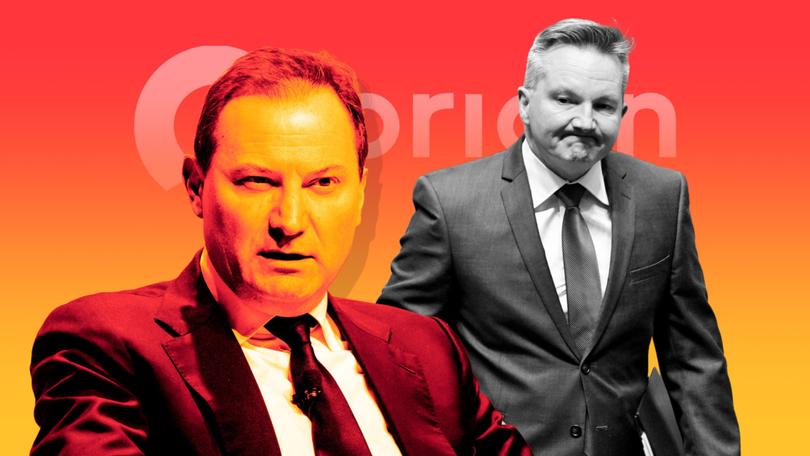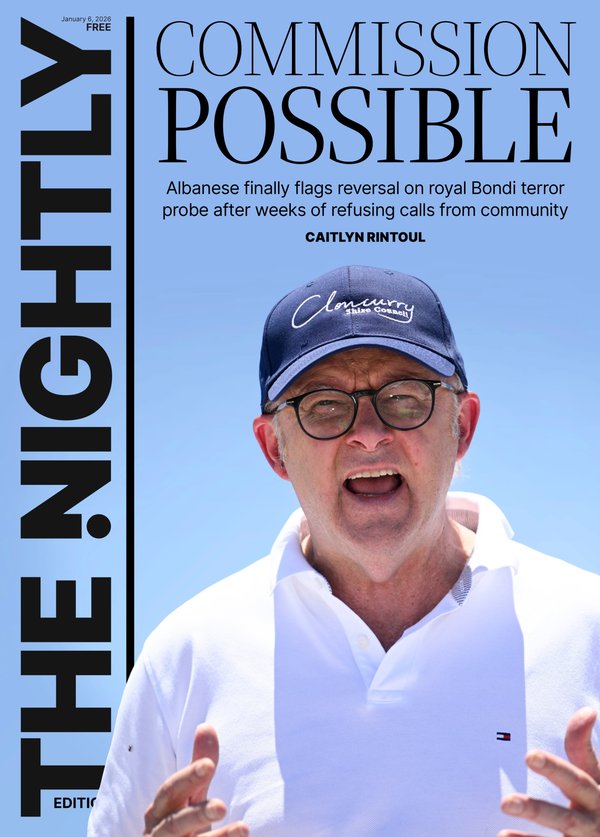PAUL MURRAY: Federal minister Chris Bowen’s hydrogen plans are a complete waste of time and energy

Loquacious Energy Minister Chris Bowen has accused his critics of gloating as Labor’s plan to blow around $12 billion in taxpayer-funded subsidies on a green hydrogen dream runs into serious headwinds.
Faced with the recent retreat from the hydrogen bubble of its biggest booster, billionaire Andrew Forrest, the Albanese Government’s most dangerous minister went on the attack.
In his sights was anyone who thought he relies too heavily on hydrogen’s potential role in the renewables transition, worried that he favours an unproven proposition over conventional gas as a crucial “firming” fuel.
Sign up to The Nightly's newsletters.
Get the first look at the digital newspaper, curated daily stories and breaking headlines delivered to your inbox.
By continuing you agree to our Terms and Privacy Policy.“They’ve celebrated in it,” Bowen protested about the reaction to Twiggy’s epiphany last month. “Gloated about any delay, any setback.”
Bowen reassured true believers that Labor was committed to spending the $4b already earmarked for “head start projects” and an additional $8 billion over the coming decade to subsidise hydrogen production.
Bottom line: We have an Energy Minister who is wildly delusional about the abilities and capacity of green hydrogen.
Unfortunately, he’s like one of those Bozo the Clown bop bags that bounce straight back up after they’ve been knocked down.
But now, less than three weeks after Bowen’s “gloating” whinge, he’s been belted again.
One of Australia’s biggest energy companies, Origin, has pulled out of his star project, the Hunter hydrogen hub, near Newcastle in his home State. When he handed over $70 million of your cash as start-up funding to the proponents last year, Bowen described it as “an essential part of Australia’s renewable energy transformation”.
Once again, Labor is picking winners, despite an appalling track record.
The Hunter hub was to be the biggest in what Bowen touted as a “pipeline” of green hydrogen projects. He should know that hydrogen notoriously corrodes pipes, one of its many problems.
Origin’s boss Frank Calabria told the stock exchange last week that the $200m it planned to invest in producing hydrogen fuel was too risky with “input cost and technology advancements to overcome”.
So both too expensive and technologically too difficult.
And the hurdles facing Origin are the same for any others in Bowen’s fantasyland private investment “pipeline”.
What Bowen sees in his critics isn’t gloating. It’s a look of horror.
Because anyone following Labor’s renewables transition knows he was relying on green hydrogen to play a major — in his own words “essential” — role in phasing out not only coal by 2030, but also natural gas, as demanded by the Greens.
So what will fill the energy transition shortfall now that green hydrogen has, at least temporarily, hit the wall?
Market operator AEMO foreshadows looming natural gas shortages on the east coast and even in gas-rich WA well before the end of the decade, by which time Labor wants coal extinguished as an Australian energy source. It currently provides 46 per cent of the nation’s electricity.
Origin’s decision showed that even the promise of massive amounts of subsidies to green hydrogen schemes can’t make them work commercially.
Labor’s May Federal Budget included a $2b expansion to the Hydrogen Headstart program for large-scale green hydrogen projects and an extra $6.7b from 2027 over a decade for tax credits of $2000 per tonne produced.
Bowen said then the cash would help “unlock $50b in private sector investment and see Australia’s annual domestic production capacity exceed 1 million tonnes of green hydrogen by 2030”.
The day Bowen bleated about gloating, he released the Federal Government’s updated green hydrogen strategy which sets five-year milestones for hydrogen output, with a target of producing at least 15 million tonnes annually and a so-called “stretch potential” of 30 million tonnes by 2050.
To give some context to Bowen’s ambition, only one million tonnes of green hydrogen was produced internationally last year in the entire globe.
Bowen in 2022 blithely rejected natural gas as a “transition fuel” but later grudgingly accepted some role after AEMO’s energy shortfall warnings.
However, his intransigence has caused damaging uncertainty for those trying to secure essential gas supplies to 2050 — and beyond.
This is not the way a mature government determines something so fundamental to the nation’s economic future as meeting its energy demands.
At a Carbon Market Institute summit in Sydney in September, last year, Bowen predicted electric planes would be in the skies by the end of this decade and that a green hydrogen industry would be up and running by then.
Will those planes be full of pigs?
“The economics of green hydrogen are very promising,” Bowen told the summit. “I’m not here to pretend green hydrogen will be replacing gas in 2026-27 — that’s not a realistic time frame. I think we will see real green hydrogen developments well and truly by 2030, at their early stages.”
Back in 2019, the Morrison government got Australia’s chief scientist, Alan Finkel, to draw up the first national green hydrogen strategy. It was a modest document, later backed by a $1.2b commitment to help establish so-called hydrogen hubs.
The coalition’s strategy took a “technology-neutral” approach, exploring both the potential of hydrogen production using renewable energy sources like wind and solar, as well as through the use of coal and gas combined with carbon capture and storage. That’s so-called brown or grey hydrogen.
“If you can do hydrogen production cost-effectively from a fossil fuel pathway, being methane or coal, with substantial carbon capture and storage … then so be it,” Finkel told a Clean Energy Council forum in December 2019. “Can you do that cost-effectively? The answer is maybe.
“Today, it could be cheaper than electrolysis from solar and wind. Will it be 10 years from now? Or 20 years from now, cheaper than electrolysis? I don’t know.”
Since that time, any form of hydrogen other than fully green has been completely shunned — Twiggy almost called it a war crime — and when Labor came to power in 2021, Bowen seized the concept like a zealot.
However, over that same timeframe, Finkel became a hydrogen sceptic.
He told the Australian Financial Review in July this year it was “increasingly clear that green hydrogen is too expensive” and Australia was “unlikely to use hydrogen for storage of electricity”.
Finkel’s comments were a dagger into those, like Bowen, who have promoted green hydrogen as an energy source to replace both coal and gas.
The Liberals are offering nuclear to fill the emerging gap, with gas in the interim. Labor ridicules it, foolishly relying on only renewables and hydrogen.
“The main role for green hydrogen production in Australia will be as a chemical to produce decarbonised products for export, such as green iron, green alumina, green ammonia, green fertiliser, green jet fuels and renewable diesel,” Dr Finkel said.
“Using renewable electricity to make green hydrogen, then store it, then feed it to a converted gas generator is expensive and inefficient.
“The alternative is to use batteries (and) the price of batteries is following a stunning downward trajectory.”
And there’s the next problem on this disappointing journey. Picking batteries as a winner is also fraught with danger.
The lies Labor is telling about the role of batteries are nearly as bad as those about hydrogen.
The Cook Government this week claimed Synergy’s $1.6 billion Collie battery, due for completion by December, “will be able to power 785,000 average homes for four hours”.
While that would be a very expensive solution for very little result, it’s smoke and mirrors. Demonstrably.
“The Collie battery will join Synergy’s existing battery systems in Kwinana, soaking up excess solar and wind energy during the day to provide system stability and support continued uptake of renewables in the South West Interconnected System,” Premier Roger Cook said.
If that battery is operational in December, it will be charged mainly from the 70 per cent fossil fuel power that currently energises the SWIS — and probably remain so for many years.
After that ends, it’s anyone’s guess where the recharging power comes from at the current rate of renewables instalment — and the Government never says definitively.
An expert paper presented this week to an Electric Energy Society of Australia conference in Perth shows that if all $6.5b of batteries proposed for WA are installed in a net zero environment, they would save only $128m annually in gas generation costs.
Do the maths on 20-year battery lifespans. But massive unquantified investment in wind and solar would also be needed to charge them.
“The SWIS could be operated without fossil fuels, at exorbitant cost, for up to 14 hours of low wind, after which battery storage would be exhausted and failure risk is high,” the paper concludes.
However, we get 36-hour wind droughts in WA. Killer days for renewables.
Modelling shows the real cost of power from the batteries would be $213/Mwh in 2030. The wholesale cost in SWIS now is between $50-$60.
Bowen is not the only threat to our energy future.
